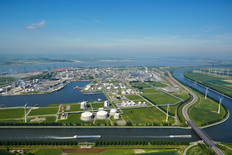- Kairos@C will avoid 14.2 million tons of CO2 over the first 10 years.
- The project will be operational in 2025.
- Air Liquide will use CryocapTM technology and BASF will use Sorbead® solution.
- Kairos@C is part of the Antwerp@C consortium aiming to halve CO2 emissions in the Port of Antwerp by 2030.

Project Overview
Air Liquide and BASF are developing the world's largest cross-border Carbon Capture and Storage (CCS) value chain, named Kairos@C, to reduce CO2 emissions at the industrial cluster in the port of Antwerp. The project has been selected for funding by the European Commission's Innovation Fund, one of seven large-scale projects chosen from over 300 applications.
Environmental Impact
Kairos@C aims to avoid 14.2 million tons of CO2 emissions over its first 10 years of operation, contributing significantly to the EU's goal of climate neutrality by 2050. The project will combine CO2 capture, liquefaction, transportation, and storage on a large scale in the North Sea.
Technological Innovations
Air Liquide will employ its patented CryocapTM technology for capturing CO2 from production plants, while BASF will use its Sorbead® solution for drying the CO2. The project is scheduled to be operational by 2025.
Future Developments
Kairos@C will connect to shared CO2 transport and export infrastructures, including a pioneering CO2 liquefaction and export terminal. This terminal will be built under the Antwerp@C consortium, which aims to halve CO2 emissions in the Port of Antwerp by 2030. Air Liquide and BASF are founding members of this consortium.
European Innovation Fund
The European Innovation Fund, one of the world's largest programs for promoting innovative low-carbon technologies, is providing essential funding for Kairos@C. This support is a crucial milestone for making a final investment decision and starting the project's execution.

